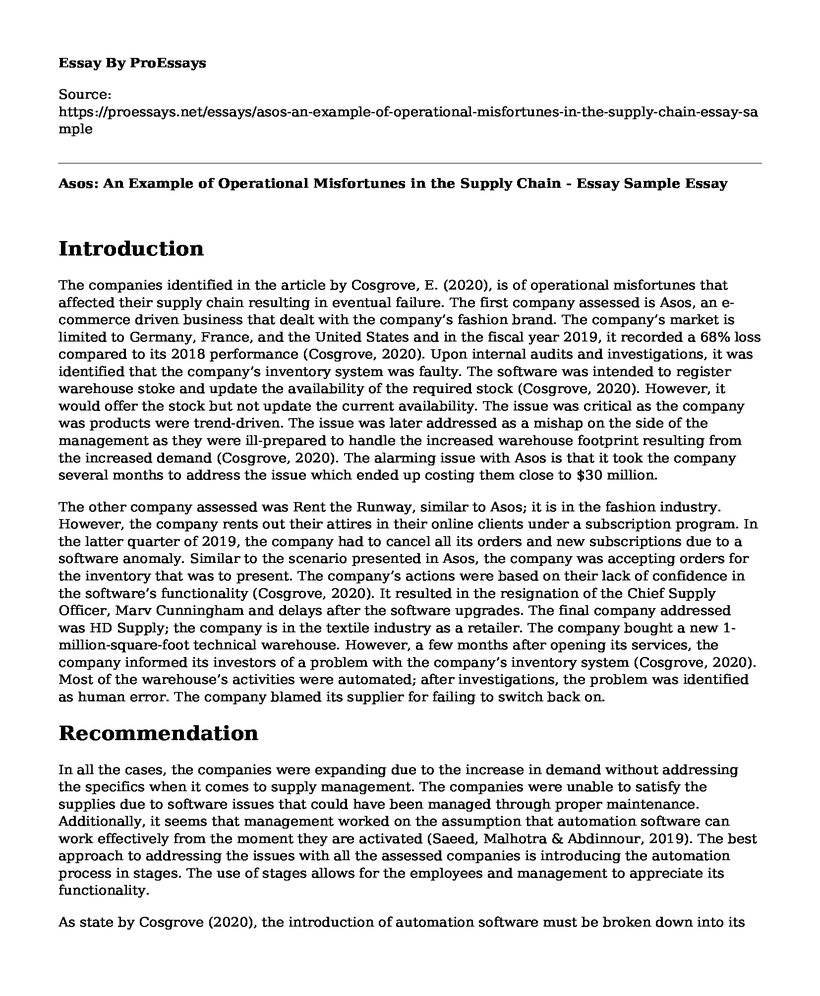Introduction
The companies identified in the article by Cosgrove, E. (2020), is of operational misfortunes that affected their supply chain resulting in eventual failure. The first company assessed is Asos, an e-commerce driven business that dealt with the company’s fashion brand. The company’s market is limited to Germany, France, and the United States and in the fiscal year 2019, it recorded a 68% loss compared to its 2018 performance (Cosgrove, 2020). Upon internal audits and investigations, it was identified that the company’s inventory system was faulty. The software was intended to register warehouse stoke and update the availability of the required stock (Cosgrove, 2020). However, it would offer the stock but not update the current availability. The issue was critical as the company was products were trend-driven. The issue was later addressed as a mishap on the side of the management as they were ill-prepared to handle the increased warehouse footprint resulting from the increased demand (Cosgrove, 2020). The alarming issue with Asos is that it took the company several months to address the issue which ended up costing them close to $30 million.
The other company assessed was Rent the Runway, similar to Asos; it is in the fashion industry. However, the company rents out their attires in their online clients under a subscription program. In the latter quarter of 2019, the company had to cancel all its orders and new subscriptions due to a software anomaly. Similar to the scenario presented in Asos, the company was accepting orders for the inventory that was to present. The company’s actions were based on their lack of confidence in the software’s functionality (Cosgrove, 2020). It resulted in the resignation of the Chief Supply Officer, Marv Cunningham and delays after the software upgrades. The final company addressed was HD Supply; the company is in the textile industry as a retailer. The company bought a new 1-million-square-foot technical warehouse. However, a few months after opening its services, the company informed its investors of a problem with the company’s inventory system (Cosgrove, 2020). Most of the warehouse’s activities were automated; after investigations, the problem was identified as human error. The company blamed its supplier for failing to switch back on.
Recommendation
In all the cases, the companies were expanding due to the increase in demand without addressing the specifics when it comes to supply management. The companies were unable to satisfy the supplies due to software issues that could have been managed through proper maintenance. Additionally, it seems that management worked on the assumption that automation software can work effectively from the moment they are activated (Saeed, Malhotra & Abdinnour, 2019). The best approach to addressing the issues with all the assessed companies is introducing the automation process in stages. The use of stages allows for the employees and management to appreciate its functionality.
As state by Cosgrove (2020), the introduction of automation software must be broken down into its individual sections such as “lego” structure (Cosgrove, 2020). In supply chains, the chain aspect refers to the various companies involved within the business. It is essential for all parties involved to have a proper understanding of the operation of the software before full implementation and execution. The identified approach would also allow for recovery from such incidents described above as the complexity would be low (Arunachalam, Kumar & Kawalek, 2018). Technology is increasingly becoming an essential aspect of supply chain management as it promotes efficiency in all aspects. Therefore, in its implementation, it is essential that management addresses the issue in stages.
References
Arunachalam, D., Kumar, N., & Kawalek, J. (2018). Understanding big data analytics capabilities in supply chain management: Unravelling the issues, challenges and implications for practice. Transportation Research Part E: Logistics And Transportation Review, 114, 416-436. doi: 10.1016/j.tre.2017.04.001
Cosgrove, E. (2020). 3 retail supply chain fails of 2019 and how to avoid them in 2020. Retrieved 13 May 2020, from https://www.supplychaindive.com/news/retail-supply-chain-fails/570748/
Saeed, K., Malhotra, M., & Abdinnour, S. (2019). How supply chain architecture and product architecture impact firm performance: An empirical examination. Journal Of Purchasing And Supply Management, 25(1), 40-52. doi: 10.1016/j.pursup.2018.02.003
Cite this page
Asos: An Example of Operational Misfortunes in the Supply Chain - Essay Sample. (2023, Aug 02). Retrieved from https://proessays.net/essays/asos-an-example-of-operational-misfortunes-in-the-supply-chain-essay-sample
If you are the original author of this essay and no longer wish to have it published on the ProEssays website, please click below to request its removal:
- Essay on McDonald's Branding and Packaging
- Case Study Analysis on Organization Development: North County Legal Services
- Managing a Global Supply Chain: Apple Inc - Essay Sample
- Paper Example on Failing to Meet Customer Expectations: The Consequence of Poor Service
- Essay Example on Starbucks: Purchasing, Roasting, and Selling High-Quality Coffee
- Paper Sample on Consumer Psychology: The Key to Enhancing Consumer Satisfaction
- Essay Sample on Healthcare Organizations: Successful Strategies for Adapting to Constant Change







